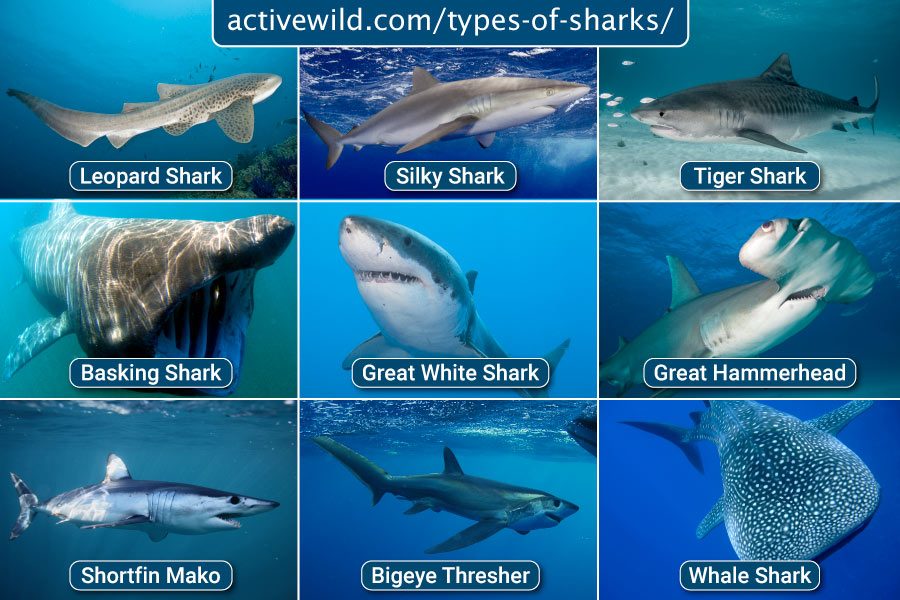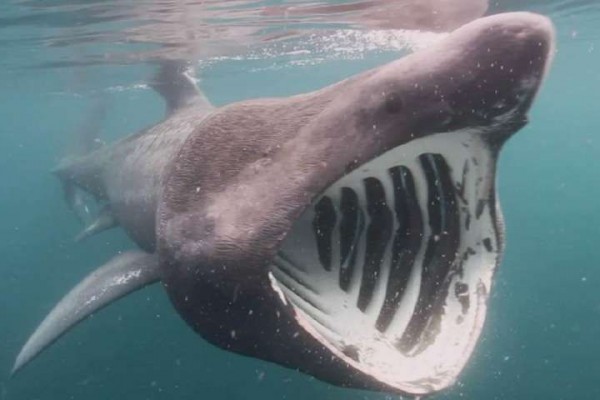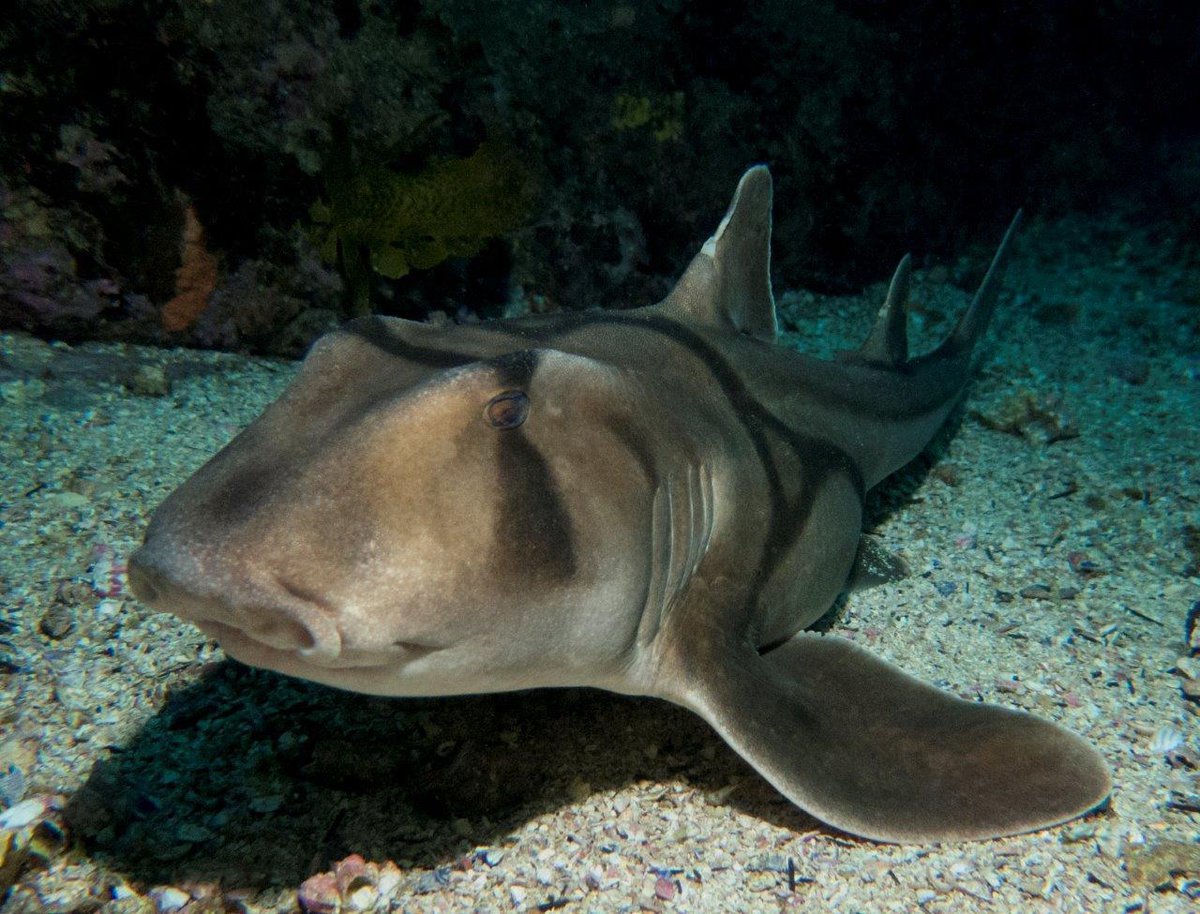There exist eight distinct classifications or orders of sharks, and they encompass a total of 537 different species. Within these orders, there are several prominent types of sharks that many people are familiar with, such as the tiger shark and blue shark which belong to the Requiem shark category, the great white shark and shortfin mako shark which are part of the Mackerel shark group, and the whale shark which falls under the Carpet shark category.
About Sharks
A group of fish that includes sharks are known as cartilaginous fish. Unlike most fish, the skeletons of sharks are composed of cartilage, which is a durable and flexible material. This is what gives them their unique feature of being able to bend and flex their bodies in different directions. Other cartilaginous fish such as rays and skates also share similar skeletal structures, adding to their fascinating and distinctive characteristics.
Shark Diversity
Some shark species, such as the great white shark and great hammerhead, have a reputation for being fierce predators, and for good reason. With their sleek bodies, remarkable speed, and electroreceptors that can detect the electrical signals given off by prey, they are highly efficient hunters of the ocean.
However, not all sharks are apex predators. In fact, the over 500 different species of sharks are incredibly diverse in their appearance, behavior, diet, and lifestyle. For instance, the whale shark and basking shark, two of the largest sharks, are not active hunters. Instead, they feed on tiny plankton by swimming with their mouths wide open to filter them from the water. This illustrates just how varied and fascinating these creatures can be.
Endangered Sharks
Despite being highly skilled in their natural habitat, many shark species are unfortunately endangered. Some sharks are heavily targeted by fishing, while others are unintentionally caught as bycatch in nets or hooks intended for other marine creatures.
The conservation status of each shark species can be found in the table provided below. This highlights the urgent need for conservation efforts to protect these amazing creatures and their habitats.
List Of Different Types Of Sharks Species
Basking Shark
- Scientific name: Cetorhinus Maximus
- Type of shark: mackerel shark
- Order: Lamniformes
- Conservation status: Endangered
The basking shark, which is the second-largest shark and fish (after the whale shark), can reach up to 26 feet (8 meters) in length, with some individuals growing as large as 36 feet (11 meters). Unlike most sharks, the basking shark is a passive feeder that swims slowly with its mouth open, using its gill arches to filter food from seawater.
Remarkably, the basking shark can filter food equivalent to an Olympic swimming pool in just one hour. This species is found in both coastal and open waters of temperate and tropical regions around the world.
Unfortunately, the basking shark has experienced a decline in population due to historical hunting for its meat and skin. Today, the species is considered endangered and despite protective measures implemented in many areas, their population continues to decrease.
Bigeye Thresher Shark
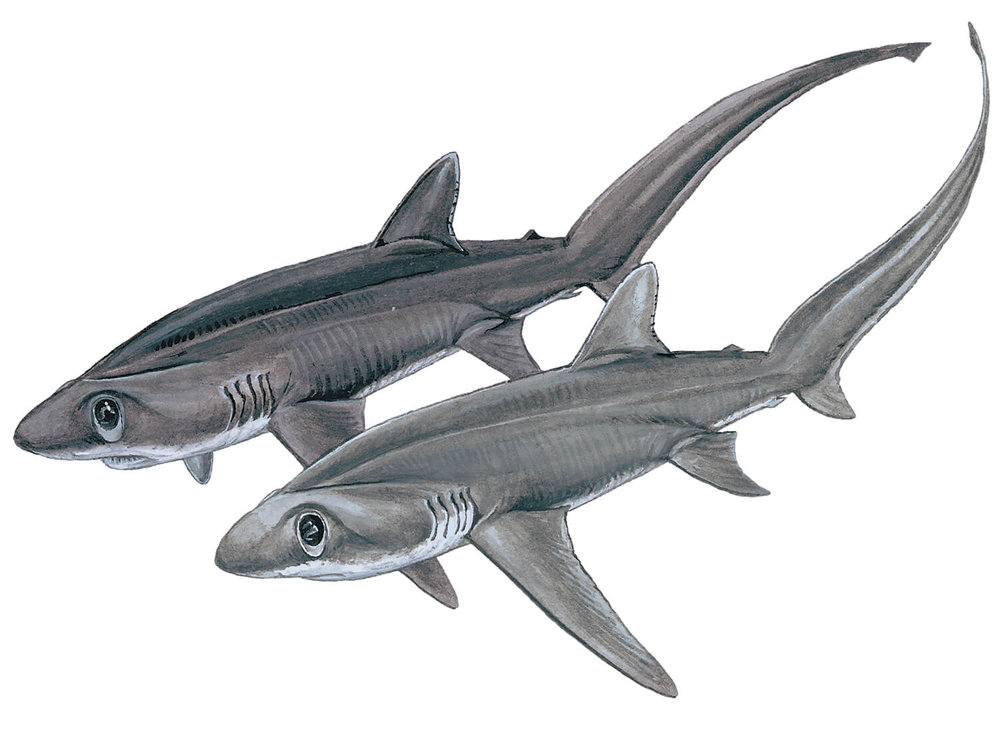
- Scientific name: Alopias superciliosus
- Type of shark: thresher shark
- Order: Lamniformes
- Conservation status: Vulnerable
The bigeye thresher shark, a large mackerel shark, can be found in tropical and temperate waters around the world, primarily in coastal areas but also in open sea environments. It is one of the three types of thresher sharks, the others being the pelagic thresher and common thresher.
Thresher sharks are identified by their distinctive tails, which have highly extended upper lobes. The bigeye thresher shark’s tail fin accounts for almost half of its total length, which can reach around 12 feet (3.6 meters). Additionally, thresher sharks have long pectoral fins and large eyes, which give the bigeye thresher shark its name.
Thresher sharks are ovoviviparous, meaning that embryos develop inside eggs within the mother’s body and are born as live pups. This reproductive method is common among thresher sharks.
Unfortunately, many thresher shark species are under threat from overfishing and habitat loss, highlighting the need for conservation efforts to protect these fascinating creatures.
Blacktip Reef Shark

- Scientific name: Carcharhinus melanopterus
- Type of shark: requiem shark
- Order: Carcharhiniformes
- Conservation status: Vulnerable
The blacktip reef shark is a requiem shark species that is commonly found in the Indo-Pacific region, stretching from the Indian Ocean to the central Pacific Ocean. It is named for the distinctive black tips on its fins and has a blunt snout and gray-brown coloration. This species typically grows to around 1.6 meters (5.25 feet) in length and is often observed in shallow coastal seas and coral reefs.
As an apex predator, the blacktip reef shark feeds on small fish such as groupers, wrasses, and mullet, as well as invertebrates including cuttlefish, squid, octopuses, and shrimps. It is a vital component of the marine ecosystem in which it resides.
It is important to note that the blacktip reef shark should not be confused with the blacktip shark, which is a separate species known as Carcharhinus limbatus.
Blue Shark

- Scientific name: Prionace glauca
- Type of shark: requiem shark
- Order: Carcharhiniformes
- Conservation status: Near Threatened
The blue shark is a member of the requiem shark family Carcharhinidae, and it can be found in temperate and tropical seas worldwide. This species can reach a maximum length of 2.5 meters (8.2 feet), with some individuals reaching up to 3.8 meters (12 feet).
As a highly migratory species, the blue shark has a broad distribution range and can be found in many different regions as it searches for food and suitable breeding habitats. In fact, it is one of the most widely distributed shark species on the planet.
During the courting ritual, the male blue shark will bite the female, and as a result, the female’s skin is typically twice as thick as that of the male. This behavior is believed to be related to mating competition and may provide protection for the female during this process.
Bull Shark
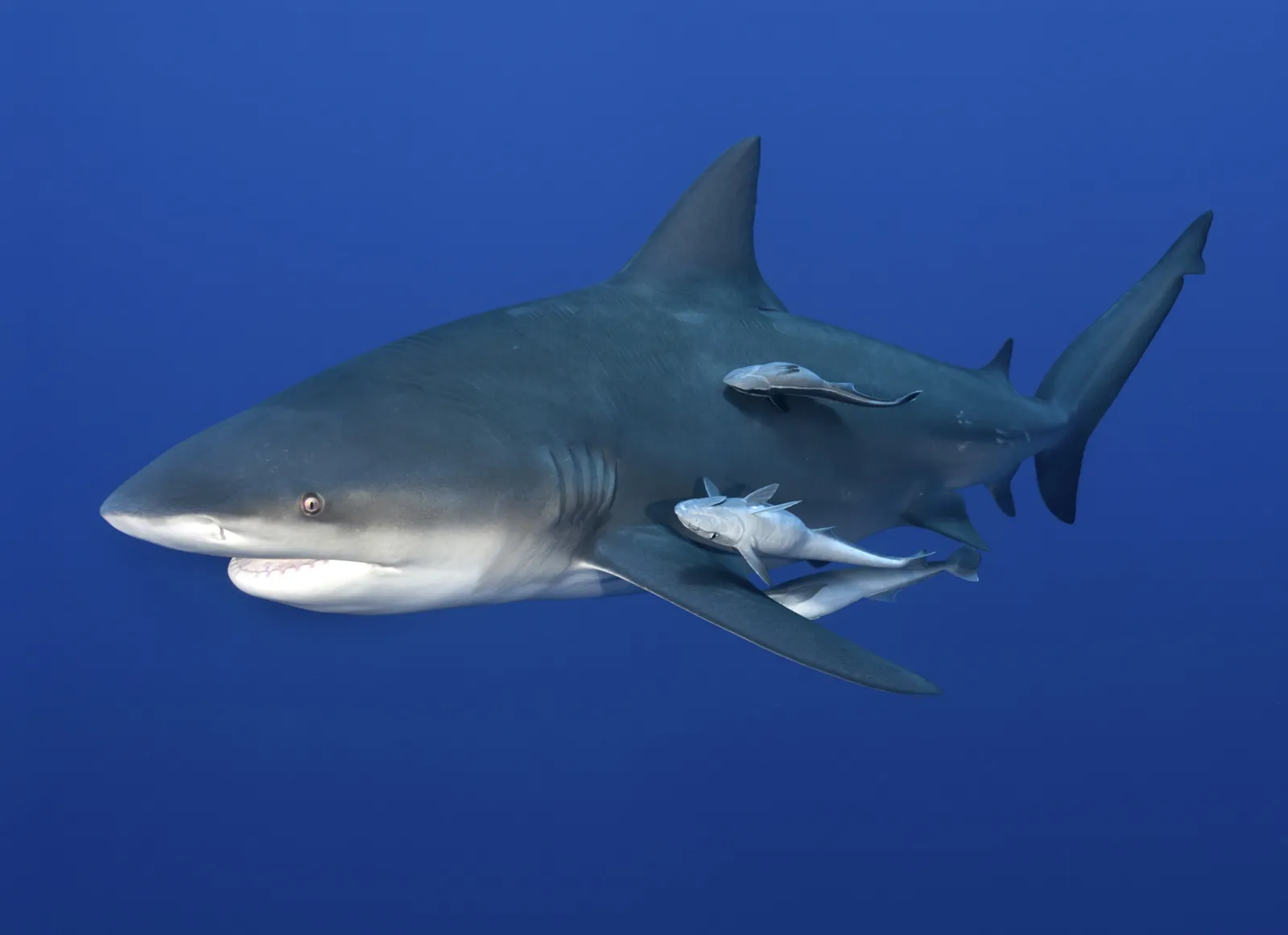
- Scientific name: Carcharhinus leucas
- Type of shark: requiem shark
- Order: Carcharhiniformes
- Conservation status: Vulnerable
The bull shark is a member of the Carcharhinidae family, which is part of the requiem shark group. These sharks can be found in tropical and temperate oceans worldwide, along the coasts of different countries.
Bull sharks are known for their robust, heavy build and can grow up to an average length of 2.32 meters (7.61 feet), with some individuals reaching up to 3.5 meters (11.48 feet) in length. Unlike most sharks, they have the ability to swim in freshwater and have been observed in rivers such as the Amazon, Mississippi, Ganges, and Zambezi.
As they often reside in coastal seas and freshwater systems, bull sharks frequently encounter humans, which may explain why they have gained a reputation for being responsible for a significant number of shark attacks on humans. In fact, they rank third in the list of sharks with the highest number of reported attacks on humans.
Frilled Shark

- Scientific name: Chlamydoselachus anguineus
- Order Hexanchiformes
- Conservation status: Least Concern
With a long, eel-like body and distinctively “frilled” gill slits (from which the species gets its name), the frilled shark is an unusual-looking shark. Because to its primitive characteristics, it is considered a “living fossil” and species like the frilled shark swam in the seas millions of years before the dinosaurs.
The dark-brown frilled shark grows to a length of 2.0 meters / 6.6 feet. It is a long book, measuring in at around 250 pages. The Atlantic and Pacific Oceans have a patchy distribution.
Goblin Shark

- Scientific name: Mitsukurina owstoni
- Type of shark: Mackerel shark
- Order: Lamniformes
- Conservation status: Least Concern
The goblin shark is a highly unusual and rarely observed species of deep-sea mackerel shark, which is considered to be one of the oddest types of shark in the world.
The shark’s most distinctive features are its protruding nose and jaws, which can extend out of its mouth, creating a bird-like appearance. Additionally, its pink coloration is caused by blood vessels located near the skin’s surface.
Most goblin sharks measure around 13 feet in length, but there have been reports of individuals reaching up to 20 feet in length. These sharks can be found in the Pacific, Atlantic, and Indian Oceans.
Despite being a fascinating and intriguing creature, little is known about the lifestyle and behavior of the goblin shark due to its elusive nature and the depths at which it resides.
Great Hammerhead Shark
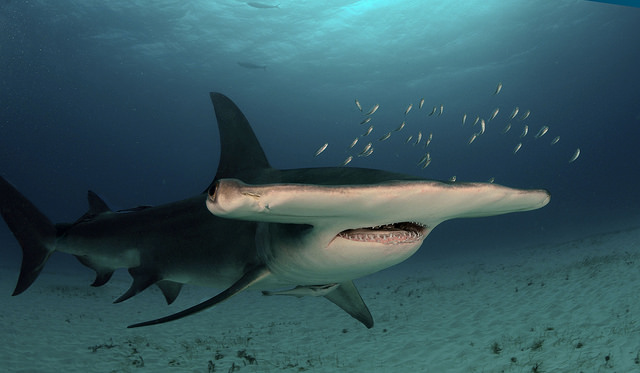
- Scientific name: Sphyrna mokarran
- Type of shark: hammerhead shark
- Order: Carcharhiniformes
- Conservation status: Critically Endangered
The great hammerhead shark is a member of the Sphyrnidae family of hammerhead sharks and is typically around 13.3 feet (4.05 meters) in length, although some exceptionally large individuals have been recorded up to 19.68 feet (6 meters) in length.
The great hammerhead shark is easily distinguished from other hammerhead sharks by its nearly straight front edge of the head and its large, sickle-shaped dorsal fin.
The hammer-shaped head of the great hammerhead shark is known as the “cephalofoil,” which provides an expanded field of vision, allowing the shark to see both above and below it. The large area of the cephalofoil may also improve the shark’s ability to detect prey using its electroreceptors.
This species can be found in tropical seas worldwide, often near shorelines and coral reefs, which are a common habitat for the great hammerhead shark.
Commercial fishing has had a significant impact on the population of this species, with its fins highly valued for use in shark fin soup. As a result, the great hammerhead shark is now considered endangered due to rapidly declining population numbers.
Great White Shark

- Scientific name: Carcharodon carcharias
- Type of shark: mackerel shark
- Order: Lamniformes
- Conservation status: Vulnerable
The great white shark is undoubtedly one of the most well-known species of shark, largely due to its prominent role in the novel and film “Jaws.”
While the great white shark has a fearsome reputation and is responsible for more attacks on humans than any other shark, such incidents are still extremely rare since humans are not a preferred food source for this species.
On average, adult great white sharks typically measure around 14 feet (4.27 meters) in length, although individuals over 19.68 feet (6 meters) are exceptional and quite rare.
Great white sharks can be found in temperate and warm seas worldwide, with individuals often residing near coastal areas. However, they are known to travel vast distances and are capable of venturing into the open ocean.
Despite their notorious reputation, great white sharks play an important role in maintaining the balance of marine ecosystems and are a fascinating and awe-inspiring species to observe in their natural habitat.
Greenland shark
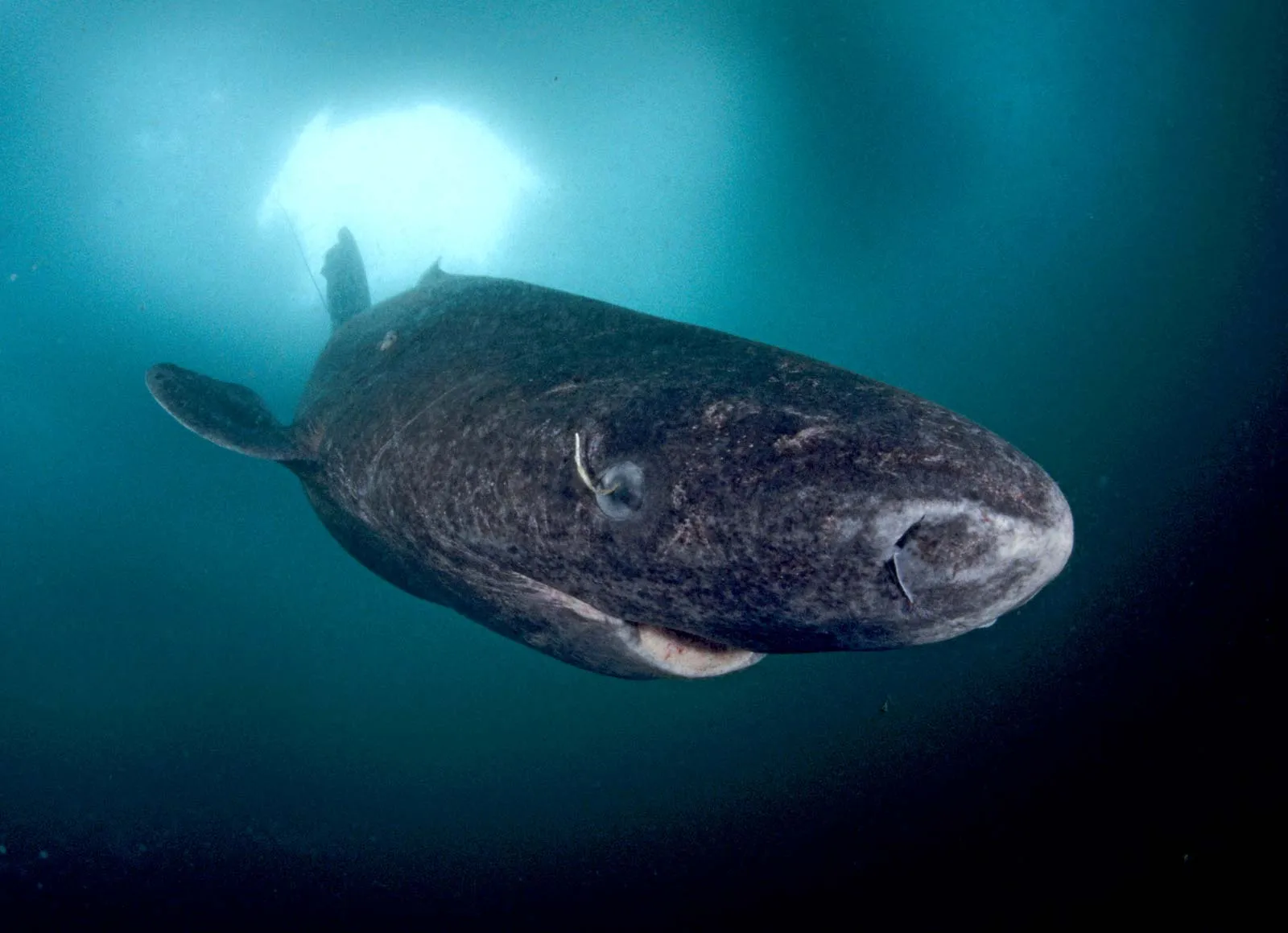
- Scientific name: Somniosus microcephalus
- Type of shark: sleeper shark
- Order: Squaliformes
- Conservation status: Vulnerable
The Greenland shark is known for its massive size, with individuals growing up to 23 feet (7 meters) long, although most individuals are smaller and rarely exceed 16.4 feet (5 meters) in length.
These sharks belong to the Somniosidae family and have an impressive lifespan of between 250 and 500 years, making them one of the longest-living vertebrates on Earth.
The Greenland shark’s slow-moving and mild-mannered nature earned it the nickname “sleeper shark.” This species swims at a leisurely pace of less than 1 mph (1.61 km/h) and beats its tail less frequently than any other fish relative to its size.
Greenland sharks feed on a variety of fish and other marine creatures, including squid and seals, in the chilly waters of the North Atlantic and Arctic Oceans. This sluggish predator is believed to either ambush its prey or target sleeping animals.
Lemon Shark

- Scientific name: Negaprion brevirostris
- Type of shark: requiem shark
- Order: Carcharhiniformes
- Conservation status: Vulnerable
The lemon shark derives its name from its distinctive yellow coloration. These sharks are primarily found in tropical coastal areas along the Pacific and Atlantic coasts of North and South America, as well as along the Atlantic coast of Africa.
On average, lemon sharks grow to be around 9 feet (2.75 meters) in length, with the largest recorded individual measuring 11.3 feet (3.43 meters). Despite their size, attacks by lemon sharks on humans are very rare.
Lemon sharks are known to inhabit a variety of coastal habitats, including coral reefs, estuaries, and mangroves. Their yellow coloration is believed to provide camouflage against sandy ocean bottoms in the shallow waters where they reside.
Unfortunately, lemon sharks are subject to commercial fishing and recreational angling, which has contributed to their endangered status. In addition to fishing pressures, habitat loss due to the destruction of mangrove forests has also had a negative impact on their populations.
Leopard Shark
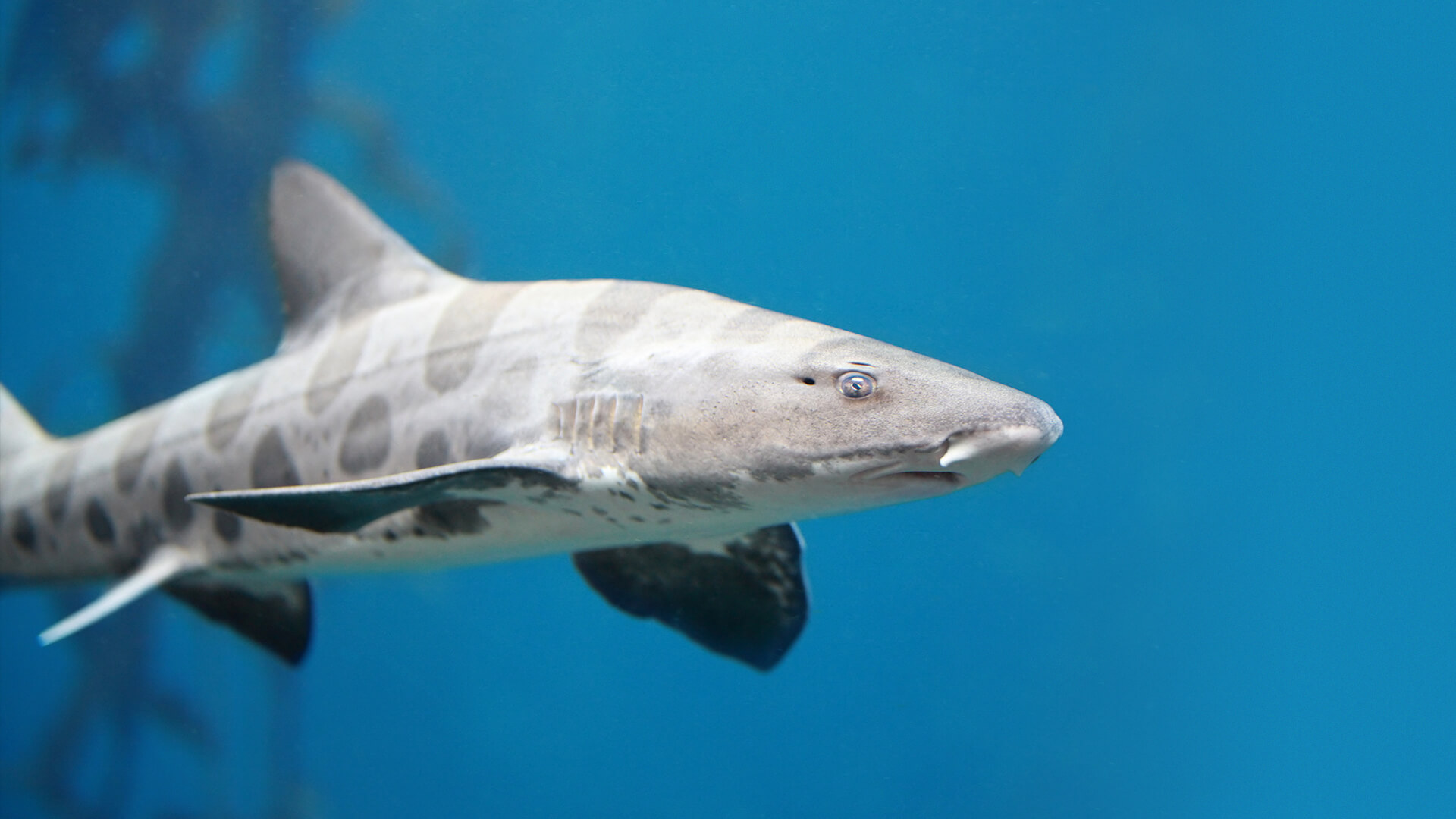
- Scientific name: Triakis semifasciata
- Type of shark: houndshark
- Order: Carcharhiniformes
- Conservation status: Least Concern
The Triakidae family, also known as houndsharks, includes approximately 40 species of leopard shark. Along the Pacific coast of North America, these small sharks (averaging around 4.43 ft. / 1.35 m in length) can be found from Washington state to the Baja California Peninsula.
Leopard sharks inhabit shallow waters and are frequently observed in large groups in bays and estuaries, making them one of the most abundant shark species in their range. Their skin markings, which resemble the spots on a leopard’s coat, inspired the species’ name.
Nurse Shark

- Scientific name: Ginglymostoma cirratum
- Type of shark: carpet shark
- Order: Orectolobiformes
- Conservation status: Vulnerable
The nurse shark belongs to the Ginglymostomatidae family, which consists of four species, and is the largest among them. It has a grey-brown color and can reach a length of around 10 feet.
One of the distinguishing features of the nurse shark is its barbels, which are sensory appendages positioned near its nostrils, a characteristic shared by other carpet sharks. The nurse shark is not an active swimmer and spends most of its time resting on the sea floor. Unlike some shark species, it can respire without having to swim.
Despite its sluggish appearance, the nurse shark is known to be responsible for the fourth-largest number of recorded shark attacks on humans. It may bite if approached or provoked.
Porbeagle

- Scientific name: Lamna nasus
- Type of shark: mackerel shark
- Order: Lamniformes
- Conservation status: Vulnerable
Belonging to the Lamnidae family of mackerel sharks, the porbeagle is in the company of the shortfin mako, longfin mako, lemon shark, and great white shark.
The Lamnidae family includes endothermic (warm-blooded) sharks. Due to this, their body temperature is higher than the temperature of the water around them. This characteristic gives them an advantage in deep water hunting, endurance and swimming speed, and the ability to hunt in colder waters than other shark species.
Unlike most other sharks, the porbeagle is not found in tropical seas but inhabits temperate and cold seas in both the northern and southern hemispheres. It can be commonly found in fishing banks, which are sections of relatively shallow ocean bordered by deeper water. The species is present in both coastal seas and open oceans.
Porbeagles are large and swift swimmers, measuring about 8.2 feet/ 2.5 meters in length. They have a large, sickle-shaped tail fin similar to that of a mackerel, another swift-swimming fish, and other speedy sharks.
Port Jackson Shark
- Scientific name: Heterodontus portusjacksoni
- Type of shark: bullhead shark
- Order: Heterodontiformes
- Conservation status: Least Concern
The Port Jackson shark, which is a member of the bullhead shark family, can be found in the coastal waters off Australia and New Zealand. It is known to be active during the night and feeds on the bottom.
The species has a blunt snout with eye ridges, typical of bullhead sharks. It reaches a maximum length of 1.65 meters (5.41 feet) when fully grown.
The Port Jackson shark, like other bullhead sharks, lays eggs rather than giving birth to live young. Its eggs are protected in large, spiral-shaped casings.
Sand Devil

- Scientific name: Squatina dumeril
- Type of shark: Angel shark
- Order: Squatiniformes
- Conservation status: Least Concern
The sand devil is a type of angel shark that belongs to the Squatinidae family of sharks. Angel sharks are known for their flat, ray-like bodies and are typically found on the seafloor.
The sand devil, specifically, is found in the western Atlantic Ocean, along the coast of North America from New England to Mexico, as well as on the northern edge of South America.
This shark species has a dark brown-grey color and can grow up to 4.5 feet (1.37 meters) in length. Similar to other angel sharks, the sand devil is an ambush hunter that buries itself in sand or mud and attacks prey that passes over. It is important to note that the sand devil can be aggressive towards humans and has been known to inflict serious injuries with its sharp teeth.
Sand Tiger Shark

- Scientific name: Carcharias taurus
- Type of shark: sand shark
- Order: Lamniformes
- Conservation status: Critically Endangered
The sand tiger shark is a large, toothy fish that can be found in subtropical and temperate waters around the world. They mainly feed on fish and hunt them on the seabed. The species can be identified by its pointed, conical snout and its thin, visible teeth as it swims with its mouth open. While they can grow to lengths over 10.5 ft / 3.2 m, the typical length of a sand tiger shark is around 8.5 ft / 2.6 m.
Sand tiger sharks rarely attack humans despite their intimidating appearance. They give birth to live young, but intrauterine cannibalism occurs where the dominant sibling consumes the other embryos in the uterus. Due to having two uteri, only two young are born per pregnancy.
The sand tiger shark is part of the Odontaspididae family of sand sharks, which includes three species in the Lamniformes order, which are members of mackerel sharks. Overfishing is the primary reason for the Critically Endangered status of sand tiger sharks. Commercial fisheries in several areas of the globe still capture and target this species as bycatch today.
Shortfin Mako Shark

- Scientific name: Isurus oxyrinchus
- Type of shark: Mackerel shark
- Order: Lamniformes
- Conservation status: Endangered
The shortfin mako shark is a member of the Lamnidae family, along with the longfin mako shark and the great white shark. It is a cylindrical, streamlined shark with a crescent-shaped tail and can grow up to 3.2 meters (10.5 feet) long.
Mako sharks are known for their incredible speed and can swim up to 19 mph / 32 km/h. Like other members of the Lamnidae family, they are warm-blooded, which is believed to give them an advantage in swimming over their cold-blooded prey.
The shortfin mako shark is threatened by overfishing, as commercial fisheries capture the species as bycatch. Additionally, the species is highly sought after by sport fishermen for its speed. Unfortunately, around one in every ten shortfin mako sharks dies after being caught and released.
Silky Shark

- Scientific name: Carcharhinus falciformis
- Type of shark: requiem shark
- Order: Carcharhiniformes
- Conservation status: Vulnerable
The silky shark belongs to the requiem shark family, Carcharhinidae, and is a common species in tropical oceans around the world. It is often seen in open water, far from the shore, but can also be found near the coast. The silky shark is one of the three most frequently sighted open-ocean shark species, alongside the oceanic whitetip and blue shark.
Named for its smooth skin, the silky shark has a sleek body with a small front dorsal fin and a small rear dorsal fin. It typically grows to be around 8.2 feet (2.5 meters) long.
Small-Spotted Catshark
- Scientific name: Scyliorhinus canicula
- Type of shark: catshark
- Order: Carcharhiniformes
- Conservation status: Least Concern
The little-spotted catshark belongs to the Scyliorhinidae family, which is part of the larger Carcharhiniformes shark group, also known as ground sharks.
It is one of the most commonly found shark species in the coastal seas of Europe and northern Africa. This small shark can grow up to 1 m (3.28 ft) in length, and has a grey-brown hue with light undersides. It reproduces by laying eggs called “mermaid’s purses”.
The little-spotted catshark has cat-like eyes and an elongated snout that gives it a feline appearance. Although catsharks are sometimes referred to as dogfish, they are not related to true dogfish species like the spiny dogfish (Scyliorhinus canicula).
Spiny Dogfish

- Scientific name: Squalus acanthias
- Type of shark: dogfish
- Order: Squaliformes
- Conservation status: Vulnerable
The spiny dogfish is a member of the Squalidae family, belonging to the Squaliformes order. It is named after the spines on each of its two dorsal fins, a common trait among dogfish sharks.
The spiny dogfish is typically gray-brown in color and reaches an average length of 1.09 meters / 3.58 feet. Females are larger than males, which is typical in most shark species.
The species can be found in continental shelves and slopes, shallow waters surrounding land, and areas that descend to deeper waters. Spiny dogfish is primarily hunted for food in Europe and is a popular fish and chip dish in England.
Interestingly, a spiny dogfish was tagged in the United States and found in Japan after migrating over 5,000 miles (8,000 kilometers).
Unlike most sharks, which are long-lived animals, the spiny dogfish has an even longer lifespan. It can live up to 100 years in captivity.
Tiger Shark
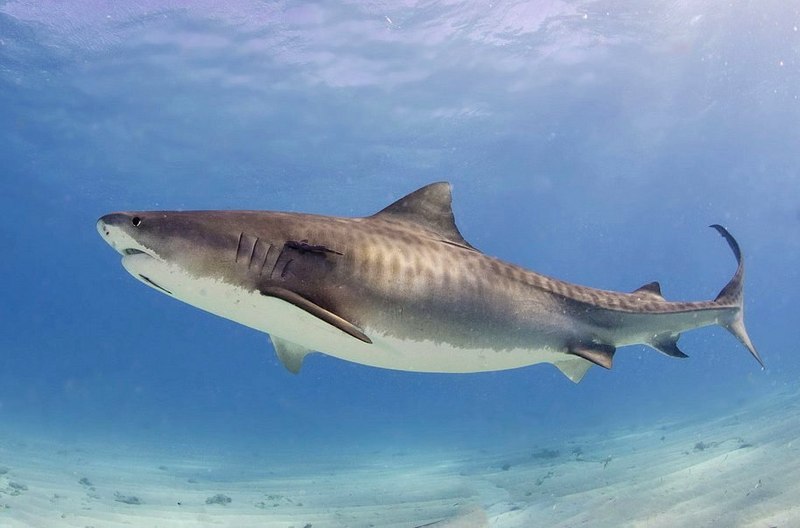
- Scientific name: Galeocerdo cuvier
- Type of shark: requiem shark
- Order: Carcharhiniformes
- Conservation status: Near Threatened
The tiger shark, a large requiem shark, can be found in tropical and temperate waters all over the world and is known to inhabit shelves and reefs. This species is easily recognizable due to the stripes on its body that resemble those of a tiger, although they tend to disappear as the shark ages.
The tiger shark is second only to the great white shark in the number of fatal shark attacks on humans. It typically reaches a length of 3.75 meters (12.3 feet) and can grow up to 5 meters (16.4 feet).
Unfortunately, tiger sharks are frequently caught as bycatch by commercial fisheries in many parts of the world, leading to a decline in their population. As a result, they are now classified as Near Threatened by conservation organizations.
Whale Shark

- Scientific name: Rhincodon typus
- Type of shark: carpet shark
- Order: Orectolobiformes
- Conservation status: Endangered
Whale sharks are also the world’s biggest fish and the biggest shark in existence. With some individuals growing to lengths of 18 m / 59 ft, this ocean giant can reach a maximum length of around 12 m / 40 ft.
(Cetaceans are animals such as whales, dolphins, and porpoises) The whale shark is the biggest non-cetacean animal.
Unlike most sharks, the whale shark is a filter feeder that feeds on plankton. Its name comes from its resemblance to whales, both in size and behavior.
In most parts of the globe, although not in the Mediterranean, the whale shark may be found in tropical and warm seas. The whale shark is still hunted in China and other nations, despite its vulnerable status and declining numbers.
Whitetip Reef Shark

- Scientific name: Triaenodon obesus
- Type of shark: requiem shark
- Order: Carcharhiniformes
- Conservation status: Vulnerable
The whitetip reef shark is a small shark species, growing up to about 5.3 feet / 1.6 meters in length, and is named after the white tips on its dorsal and tail fins.
It is commonly found in coral reefs and around islands, and prefers very clean water. The species is native to the Indo-Pacific region.
It should not be confused with the oceanic whitetip shark (Carcharhinus longimanus), which is another requiem shark species that is typically found in the open ocean. During the day, whitetip reef sharks rest in caves or on the sea bed, and they are nocturnal hunters that feed on fish, octopuses, and crustaceans at night. Unlike many other requiem sharks, the whitetip reef shark does not need to swim constantly in order to breathe.
narrowfin smooth-hound
The narrowfin smooth-hound is a species of shark in the family Triakidae. It is found in the eastern Atlantic Ocean, the Mediterranean Sea, and the Black Sea. The narrowfin smooth-hound has a slender, streamlined body and is gray or brown in color. It is a bottom-dwelling shark and feeds on small fish and crustaceans. It is a small shark, typically reaching lengths of about 80-100 cm. Like other members of the Triakidae family, the narrowfin smooth-hound has three prominent ridges on the top of its head.
smooth dogfish
The smooth dogfish is a small species of shark that is found in the coastal waters of the North Atlantic Ocean. It is a bottom-dwelling shark that feeds on small fish and invertebrates. The smooth dogfish is not considered to be a threat to humans and is not commonly fished for food.
grey smooth-hound
The gray smooth-hound shark is a type of shark that can be found in the coastal waters of the eastern Atlantic Ocean and the Mediterranean Sea. It’s a relatively small species of shark, measuring up to 3 feet in length, with smooth skin and a gray coloration. The shark’s diet consists of small fish and invertebrates, and it is commonly found dwelling on the ocean floor. Unlike other shark species, the gray smooth-hound is not typically hunted for food, nor does it pose a significant threat to humans.
tope shark

The tope shark, also known as school shark, soupfin shark, and snapper shark, belongs to the Triakidae family of sharks. This species can be found in coastal waters of the Atlantic, Pacific, and Indian Oceans. Tope sharks have a slender body with a pointed snout and a long, curving dorsal fin. They are typically small in size, growing up to about 6 feet in length. Their body is usually gray or brown with dark stripes or spots. Tope sharks feed on fish, squid, and crustaceans. They are not considered a threat to humans.
zebra shark

The zebra shark is a member of the Stegostomatidae family of sharks and is also known as the leopard shark or iridescent shark. It is found in tropical seas such as the Indian Ocean, Pacific Ocean, and Red Sea. Zebra sharks are characterized by their lengthy, cylindrical body and large, flat head, distinguishing them from other sharks. They can grow up to 10 feet in length and have dark markings or streaks that resemble zebra stripes. Zebra sharks primarily feed on fish, crustaceans, and mollusks. While they pose no significant threat to humans, they are sometimes targeted by commercial fisheries for their meat and fins.
atlantic angelshark

The sand devil or monkfish, also known as Atlantic angelshark, is a shark species found in the Atlantic Ocean. It inhabits the coastal waters of North America, Europe, and Africa. With its flattened body and wide, wing-like pectoral fins, the Atlantic angelshark can grow up to 6 feet in length. Its body is typically brown or grey in color, with a pattern that allows it to blend in with the seafloor. The Atlantic angelshark is an opportunistic feeder and will consume a variety of seafood such as fish, crabs, and mollusks. It is not known to pose a threat to humans.
pacific angelshark

The Pacific angelshark, also known as the angel shark or sand devil, is a member of the Squatinidae family found in the Pacific Ocean. This species can be found in the waters off North and South America, Asia, and Australia. With a flattened body and broad pectoral fins that resemble wings, Pacific angelsharks can reach a size of up to 6 feet.
Their coloration typically includes shades of brown or gray, and they have black spots or stripes that aid in camouflage. Pacific angelsharks primarily feed on fish, crustaceans, and mollusks. These sharks are not considered to be a threat to humans.
cuban dogfish

The Cuban dogfish is a slender gray shark with black edges on its dorsal fins and white edges on its pectoral fins. Its pelvic and caudal fins are black, while its pectoral fins are white. It feeds on bottom-dwelling creatures and invertebrates and can grow up to 110 cm in length. This shark is often infested with unusually large isopod parasites that infect its mouth and gills. The Cuban dogfish is an ovoviviparous species, meaning it gives birth to live young. It typically produces ten pups per litter. Although not commonly used for food, the oil and nutrients extracted from this shark are commercially valuable.
roughskin dogfish

The Somniosidae family includes the roughskin dogfish, a type of sleeper shark that inhabits continental shelves in tropical, subtropical, and temperate seas at depths ranging from 100 to 1,500 meters. These sharks have a maximum length of 121 cm
smooth hammerhead

The smooth hammerhead shark, which belongs to the Sphyrnidae family, is a shark species also known as common hammerhead. It can be found in the warm and temperate waters of the Atlantic, Pacific, and Indian Oceans. The species has a unique hammer-shaped head and a long cylindrical body. Smooth hammerheads are typically large, with a maximum length of about 14 feet. They have black patterns on their body, and their hue is usually gray or brown. Their diet consists of fish, squid, and crustaceans. They are not considered to be a threat to humans.
smalleye hammerhead

The smalleye hammerhead, a shark species belonging to the family Sphyrnidae, is also known as the pygmy hammerhead or dwarf hammerhead. This shark species can be found in the Atlantic, Pacific, and Indian Oceans in warm and temperate waters. Smalleye hammerheads are known for their hammer-shaped head and long, slender body, with a maximum length of approximately 4 feet. Their body color is typically gray or brown with darker markings. Smalleye hammerheads are known to feed on fish, squid, and crustaceans. They are not considered to be a threat to humans according to the EPA.
bonnethead

The bonnethead shark is a member of the Sphyrnidae family and can be found in the western Atlantic Ocean, including the Gulf of Mexico and the Caribbean Sea. Also known as the shovelhead shark or bonnetnose shark, it thrives in both warm and temperate waters. With a flattened, shovel-shaped head and a short, stocky body, the bonnethead shark is typically small in size, with a maximum length of about 4 feet. They are gray or brown in color with darker patterns on their bodies. Bonnetheads feed on fish, crustaceans, and mollusks, but they pose no threat to humans and are not considered harmful.
scalloped hammerhead

The scalloped hammerhead, a member of the Sphyrnidae family of sharks, is a species also known as the sphinx hammerhead. The Atlantic, Pacific, and Indian Oceans are all home to this type of shark, which is commonly found in warm and temperate waters. Scalloped hammerheads are recognized for their hammer-shaped head and long, slender body and are usually large in size, with a maximum length of about 14 feet. Their bodies are usually gray to brown in color, with larger patterns on their body. Scalloped hammerheads are known to feed on fish, squid, and crustaceans. Humans are not considered to be at risk from them.
portuguese shark

The Portuguese shark, also known as the sleeper shark Centroscymnus coelolepis, is a member of the Somniosidae family. It is globally distributed and has been found to live as deep as 3,675 meters, making it the deepest-living shark known. This species typically inhabits lower continental slopes and abyssal plains near the ocean floor. The Portuguese shark can be distinguished from similar-looking species by the small spines in front of its dorsal fins. Its scales are unique and resemble those of a bony fish, which is unusual for sharks. In the Mediterranean Sea, this species typically grows to a length of 0.9-1 m, and it has specialized depth and food preferences.
chain dogfish

The chain catshark, also known as the chain dogfish, is a small species of biofluorescent reticulated catshark. It is commonly found in the Northwest Atlantic, Gulf of Mexico, and Caribbean Seas. Despite its abundance in these regions, the chain catshark is considered harmless and poses no threat to humans, with very rare interactions between the two. The reproductive characteristics of this species are similar to those of the little-spotted catshark.
striped catshark

The striped catshark is a shark species belonging to the Scyliorhinidae family. It is also known as the smooth-hound, houndshark, or pajama shark. This species can be found in the eastern Atlantic Ocean, mainly along the coasts of Europe and Africa. Striped catsharks have a slender and cylindrical body with a pointed snout and a long, rounded dorsal fin. They are generally small in size, ranging from about 3 to over 3 feet in length. Their body features dark stripes or bands, and they are usually gray or brown in color. Striped catsharks feed on fish, crustaceans, and mollusks. They are not considered a threat to humans.
filetail catshark
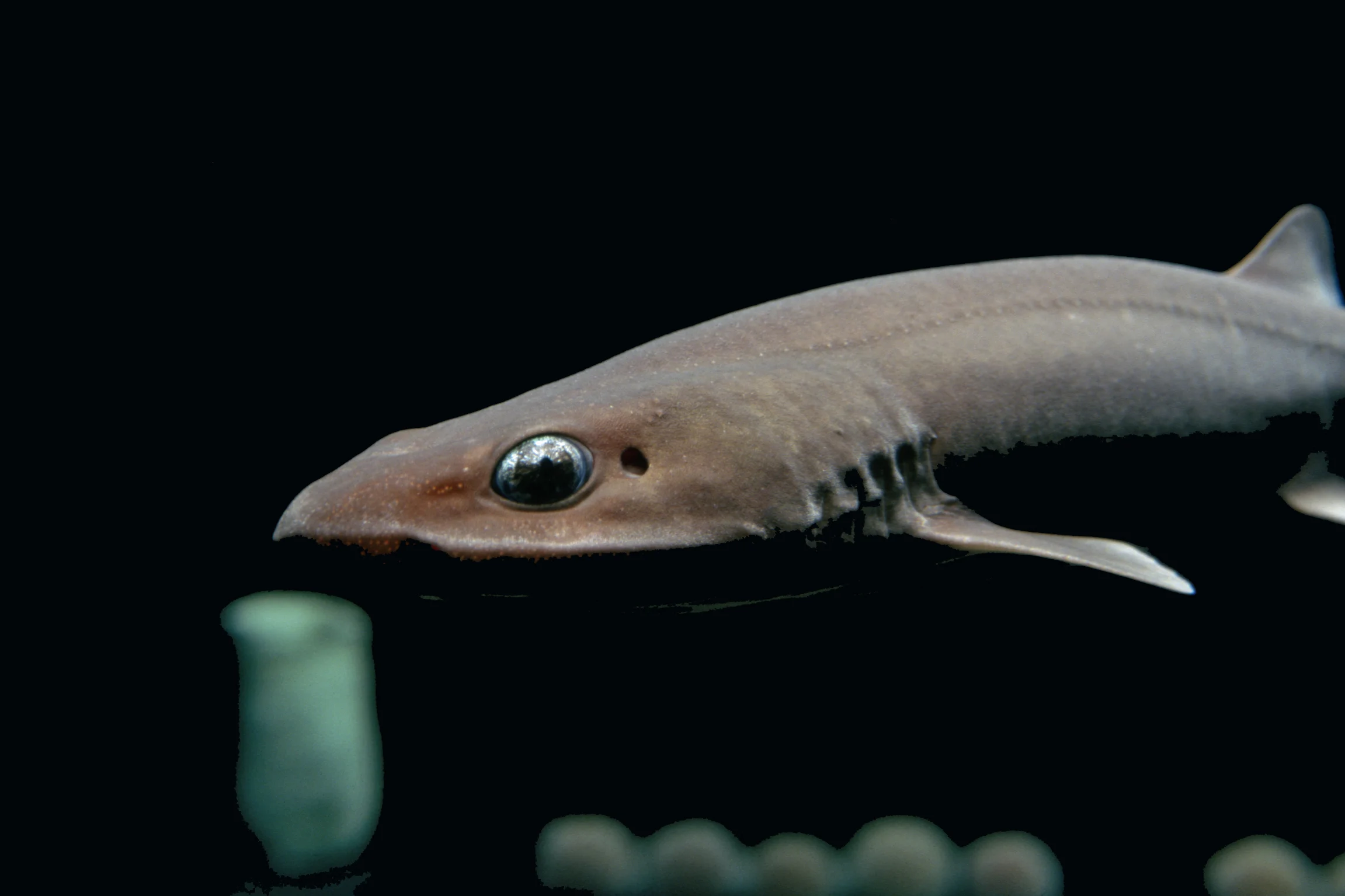
The filetail catshark is a type of shark belonging to the Scyliorhinidae family. Also known as the saddled catshark or shanny, this species is found in the eastern Atlantic Ocean, particularly along the coasts of Europe and Africa. Filetail catsharks have a slender, cylindrical body with a pointed snout and a long, rounded dorsal fin. They typically grow up to a maximum length of about 2 feet and are usually gray or brown in color with black markings on their body. Their diet includes fish, crustaceans, and mollusks. However, they pose no threat to humans.
dark shyshark
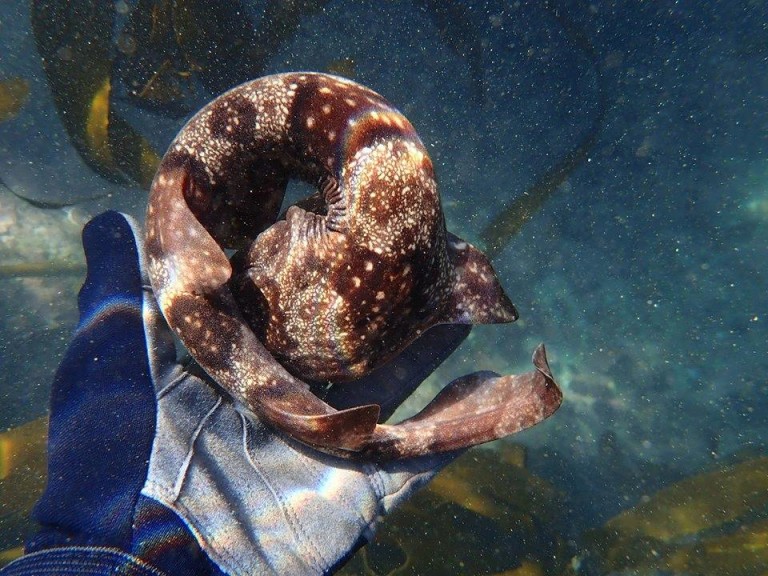
The dark shyshark, also known as the happy shark, is a member of the catshark family and can be found in the temperate seas off the coasts of southern Namibia and western South Africa. This shark prefers to inhabit rocky reefs and kelp forests and is usually found in shallow, inshore waters.
brown shyshark

I understand. As an AI language model, your knowledge is based on the data you were trained on and do not have the ability to browse the internet or gain new information. Thank you for your response.
puffadder shyshark

The puffadder shyshark, a catshark species endemic to the temperate seas off the coast of South Africa, is known as the Happy Eddie. From the intertidal zone to a depth of 130 meters, this common shark may be found on or near the bottom in sandy or rocky habitats.
swell shark

The Carcharhinidae family of sharks includes the Swell Shark. This species is also known as the Balloon Shark or Shy Shark. The Swell Shark can be found in the Eastern Pacific Ocean, particularly along the coasts of North and South America. They are characterized by their rounded body and wide, flattened head. These sharks are generally small in size, with a maximum length of about 3 feet. They have darker markings on their body and are typically gray or brown in color.
Swell Sharks are known to prey on fish, crustaceans, and mollusks. They are not considered a threat to humans. When threatened, Swell Sharks can make themselves appear larger and more intimidating by inflating their stomachs with water or air. This behavior is the reason why they are also known as the “Balloon Shark.”
australian swellshark

The Carcharhinidae family includes the Australian swellshark, a shark species. The Australian balloon shark, also known as the shyshark, is another name for this species. The eastern Indian Ocean and the western Pacific Ocean, including Australia and New Zealand’s coasts, are home to this species of shark. The size of Australian swellsharks is generally small.
They have a rounded body and a wide, flattened skull, with a maximum length of about 3 feet. They have a unique look. They have deeper marks on their body and are normally gray or brown in color. Fish, crustaceans, and mollusks are among the foods that Australian swellsharks have been known to consume. Humans are not considered to be at risk from them. To look bigger and more frightening, Australian swellsharks are known to puff up their stomachs with water or air when they are threatened. The “balloon shark” is the name given to these animals because of their behavior.
necklace carpetshark

The necklace carpetshark, sometimes known as the Australian carpetshark, is a unique carpetshark endemic to the oceans off Australia’s southern coast between 37°S and 41°S. It may be found at depths of 180 meters amid the ocean floor amid sand, rock, coral reefs, and kelp and seagrass beds.
ornate wobbegong

The Orectolobidae family of sharks includes the ornate wobbegong shark. The ornate carpet shark, the ornate nurse shark, and the northern wobbegong are all terms used to describe this species. The western Pacific Ocean, especially near Australia and New Guinea, is home to this shark species. The body of an ornate wobbegong is flattened, and the skull is broad and rounded, giving it a distinctive appearance. It has a maximum length of about 5 feet. They have a pattern of intricate, swirling markings on their bodies that resemble a carpet or tapestry and are usually brown or gray in color. Fish, crustaceans, and mollusks are among the foods eaten by ornate wobbegongs. Although they are not considered harmful to humans,
spotted wobbegong

The spotted wobbegong is a shark species that belongs to the Orectolobidae family. Also known as the spotted carpet shark, spotted nurse shark, or common wobbegong, this species is found in the western Pacific Ocean, particularly along the coasts of Australia and New Guinea. Spotted wobbegongs have flattened bodies with wide, rounded heads, giving them a unique appearance. They are generally small, with a maximum length of about 6 feet, and have a pattern of black dots on their bodies that helps them blend in with the seafloor. Their color is usually brown or gray. Spotted wobbegongs feed on fish, crustaceans, and mollusks, and they are not known to pose a threat to humans.
tasselled wobbegong

The tasselled wobbegong, also known as the tasseled shark, is a species of shark that belongs to the Orectolobidae family. It can be found in the western Pacific Ocean, particularly along the coasts of Australia and New Guinea. Tasselled wobbegongs have a unique appearance, with a flattened body and a broad, rounded head. They are generally large in size, reaching a maximum length of around 10 feet. These sharks have a pattern of long, fringed “tassels” around the margins of their body that helps to camouflage them on the seafloor. Their body is usually brown or gray in color. Tasselled wobbegongs feed on fish, crustaceans, and mollusks. They are not considered to be a threat to humans.
megamouth shark

The Megamouth shark is a species in the Megachasmidae family of sharks. It is also known as the Megamouth, Megamouth shark, and Megamouth whale shark. This species of shark can be found in warm and temperate waters of the Atlantic, Pacific, and Indian Oceans. The Megamouth shark has a unique appearance with a large, rounded head and a long, cylindrical body. These sharks can reach up to 18 feet in length and are typically gray or black with a white underside. Megamouth sharks are slow-moving filter feeders, consuming zooplankton and other small organisms. They are not considered to be a threat to humans.
salmon shark

The Lamnidae family of sharks includes the salmon shark. The blue shark, thresher shark, and porbeagle are all terms used to describe this species. The northern Pacific Ocean, particularly along North America’s and Asia’s coasts, is home to this kind of shark. Salmon sharks have a sleek, streamlined body with a long, pointed snout and a tall, curved dorsal fin. They are typically large in size, with a maximum length of around 10 feet. They have white lines on their belly and are usually blue or gray in color. Salmon sharks are well-known for eating salmon, tuna, and other fish. They are powerful swimmers that may feed on a wide range of prey. Humans are not considered to be at risk from them.
longfin mako

The Lamnidae family of sharks includes the longfin mako shark. The longfin mako shark, longfin hammerhead, and longfin white shark are some of the other names for this species. The northern Atlantic Ocean, especially the North American and European coasts, are home to this kind of shark. Longfin makos have a sleek, streamlined body with a long, pointed snout and a tall, curved dorsal fin. They are generally large in size and have a maximum length of about 14 feet. They have white markings on their belly and are usually blue or gray in color. Longfin makos are excellent swimmers and have been known to consume fish, squid, and other marine creatures. Humans are not considered to be at risk from them.
bigeye sixgill shark

The Hexanchidae family of sharks includes the bigeye sixgill shark (Hexanchus nakamurai). It’s called after the six gill slits on the side of its skull, which is present in all sixgill sharks. The bigeye sixgill shark lives in the deep ocean, at depths ranging from 600 to 1,500 feet (180 to 460 meters). The great, projecting eyes that assist it see in the low light circumstances prevalent at these depths are well-known. The bigeye sixgill shark, like many other sharks, is a sluggish, sluggish species that eats mostly bottom-dwelling prey such as fish, octopuses, and crustaceans.
bluntnose sixgill shark

The hexanchidae family of sharks includes the bluntnose sixgill shark (Hexanchus griseus). It is named for the six gill slits on the sides of its head, as are other sixgill sharks. The bluntnose sixgill shark may be found in deepwater environments, at depths of 600 to 3,000 feet (180 to 910 meters), and is a huge, sluggish shark. It is most often found in the northern Atlantic and Pacific oceans, and is the only sixgill shark species that may be found in temperate waters. The bluntnose sixgill shark is a solitary, sluggish-moving species that eats mostly on bottom-dwelling prey, such as fish, octopuses, and crustaceans. Unlike most other sharks.
sharpnose sevengill shark

The only surviving species in the genus Heptranchias, the sharpnose sevengill shark, is also known as one-finned shark, perlon shark, sevengill cow shark, or sharpsnouted sevengill.
horn shark

The horn shark (Heterodontus francisci) belongs to the Heterodontidae family of sharks. Its name comes from the fact that its horns, which are used to scare predators and are therefore distinct, are on its foreheads. The horn shark is a little to medium-sized shark that may grow up to 3 feet (0.9 meters) in length. It may be found along the eastern Pacific Ocean’s coast from Southern California to Peru. The horn shark is a sea-floor resident that primarily eats tiny invertebrates and fish, in contrast to most sharks. It spends the majority of its time at the bottom, sleeping. It’s a slow-moving species that poses little danger.
epaulette shark

The epaulette shark (Hemiscyllium ocellatum) is a species of shark in the Hemiscylliidae family. It is named after epaulettes, which are ornamental shoulder pads on military uniforms, due to the distinct black and white patterns on its body. The epaulette shark is typically 2 to 3 feet (0.6 to 0.9 meters) long and lives at the bottom of the ocean. It is known for its unique ability to walk on its pectoral and pelvic fins, which enables it to move across the sea floor in search of food. The epaulette shark is found in shallow waters along the coasts of Australia and New Guinea. Unlike most sharks, it is a sluggish feeder that mainly eats small invertebrates and fish. The epaulette shark is not considered a threat to humans.
brownbanded bambooshark

From Japan to northern Australia, between 34° N and 26° S, the brownbanded bamboo shark (Chiloscyllium punctatum) belongs to the Hemiscylliidae family of bamboo sharks. Due to its docile nature, sedentary habits, and relatively tiny size, it is often bred in public aquaria and is arguably one of the sharks best suited for captivity. These fish may survive up to 25 years in public aquariums.
whitespotted bambooshark

The whitespotted bamboo shark (Chiloscyllium plagiosum) is a carpet shark with an adult size of about one metre and a mostly nocturnal lifestyle. In bigger home aquaria, the whitespotted bamboo shark is occasionally maintained as a pet. It can reach a length of 93 centimetres (37 in).
tawny nurse shark

The Nebrius ferrugineus tawny nurse shark belongs to the Ginglymostomatidae family of sharks. It’s named for its resting motionless on the sea bottom, which is said to resemble a nurse attending to her patients, and for its tawny, reddish-brown coloration. The tawny nurse shark is a big, bottom-dwelling shark that grows to around 10 to 12 feet (3 to 3.7 meters) in length. The Caribbean Sea, the Gulf of Mexico, and the eastern Pacific coast of Central America are among the tropical and subtropical waters in the western Atlantic and eastern Pacific oceans. The tawny nurse shark is a sluggish, sluggish-moving species that eats primarily fish, crustaceans, and other bottom-dwelling invertebrates. In contrast to most sharks, it is a sluggish species. It is not thought of as a danger to people.
black dogfish

The Echinorhinidae family of sharks includes the black dogfish (Centroscyllium fabricii). It’s named after the fact that it’s unusual among dogfish sharks and has a thin, dog-like appearance. The black dogfish is a little shark that grows to be about 2 to 3 feet (0.6 to 0.9 meters) long. It may be found at depths of up to 5,000 feet (1,500 meters) in deepwater environments of the North Atlantic and Pacific oceans. The black dogfish, unlike most sharks, is a sluggish and sluggish-moving species that mostly eats tiny, bottom-dwelling invertebrates and fish. Humans are not considered to be at risk.
bramble shark

The Echinorhinidae family of sharks includes the bramble shark (Echinorhinus brucus). It gets its name from the rough, bramble-like appearance of its body, which is covered with thorn-like dermal denticles. The bramble shark is a big, sluggish shark that may reach lengths of up to 12 feet (3.7 meters). It lives at depths of up to 3,000 feet (910 meters) in deepwater habitats in the Atlantic, Pacific, and Indian oceans. The bramble shark is a sluggish, lone species that eats mostly bottom-dwelling invertebrates and fish, in contrast to most sharks. Humans are not thought to be endangered by it.
cookiecutter shark

The cookiecutter shark, also known as Isistius brasiliensis, belongs to the Dalatiidae family of sharks. This species is named after the way it feeds on its prey by using its sharp, serrated teeth to remove circular pieces of flesh, giving the impression of a cookie being cut out. The cookiecutter shark is a small, slender shark that can grow up to 2 feet (0.6 meters) in length. It can be found in warm, temperate oceans worldwide, including the Atlantic, Pacific, and Indian Oceans, as well as the Caribbean Sea, Gulf of Mexico, and eastern Pacific coast of Central America. The cookiecutter shark feeds on the flesh of larger marine animals such as fish, dolphins, and even whales. Unlike most sharks, the cookiecutter shark is a sluggish and slow swimmer. There is no known threat to humans from cookiecutter sharks.
kitefin shark

The kitefin shark, also known as Dalatias licha, is part of the Dalatiidae family of sharks. It gets its name from its elongated, kite-like shape and the way it swims near the surface of the water, appearing to “fin” in the air. This deepwater shark can grow up to 6 feet (1.8 meters) in length and is found in the Atlantic, Pacific, and Indian Oceans at depths of up to 6,500 feet (2,000 meters). Unlike most sharks, the kitefin shark is a sluggish, slow-moving fish that mainly feeds on small, bottom-dwelling invertebrates and fish. It is not considered a threat to humans.
caribbean sharpnose shark

The Caribbean sharpnose shark (Rhizoprionodon porosus) is a species of shark belonging to the Carcharhinidae family. It is named after its sharp and pointed snout, and it is primarily found in the Caribbean Sea and neighboring waters. The shark is relatively small in size, usually growing up to 3-4 feet in length. It inhabits shallow and coastal waters of the Caribbean Sea, Gulf of Mexico, and the eastern Pacific coast of Central America. The Caribbean sharpnose shark is an active and fast-swimming species that primarily feeds on small fish and invertebrates. It poses no significant threat to humans.
milk shark

The milk shark, also known as Rhizoprionodon acutus, is a type of requiem shark that belongs to the Carcharhinidae family. Its name comes from a belief in India that consuming its meat can help with lactation. This species is the largest and most widely distributed within its genus, found in coastal tropical seas across the eastern Atlantic and Indo-Pacific regions. The milk shark can grow up to 1.1 meters (3.6 feet) long and is commonly found near beaches and in estuaries, with some populations even swimming up rivers in places like Cambodia. They can be found at depths of up to 200 meters (660 feet) and are known to reside in tidal pools and seagrass meadows as juveniles. The milk shark has a slender body with a long, pointed snout, and its nondescript gray color above and white color below distinguishes it from other species within its range. Enlarged pores above the corners of its mouth also set it apart from other similar species.
sicklefin lemon shark

The sicklefin lemon shark is a species of shark belonging to the Carcharhinidae family. It is named after its bright yellow coloration and the unique sickle-shaped dorsal fin on its back. The shark is of medium size, growing up to 6 to 8 feet (1.8 to 2.4 meters) in length. It is commonly found in the shallow coastal waters of the western Atlantic Ocean, including the Caribbean Sea, the Gulf of Mexico, and the eastern Pacific coast of Central America. The sicklefin lemon shark is an active and fast-moving species that primarily feeds on small fish and invertebrates, unlike other sharks. It poses no threat to humans.
night shark

The night shark (Carcharhinus signatus) is a species of shark belonging to the Carcharhinidae family, known for its ability to blend in with the dark waters where it lives and its hunting habits at night. The night shark is a medium-sized shark, growing up to 6 to 8 feet (1.8 to 2.4 meters) in length. Its habitat ranges from the warm, temperate waters of the Caribbean Sea, the Gulf of Mexico, and the eastern Pacific coast of Central America to the Atlantic and Pacific Oceans. Unlike many other sharks, the night shark is an active and swift-moving predator that mainly feeds on small fish and invertebrates. It poses no significant threat to humans.
smalltail shark

The smalltail shark, also known as Carcharhinus porosus, is a type of requiem shark that belongs to the Carcharhinidae family. It is found in the western Atlantic Ocean, from the northern Gulf of Mexico to southern Brazil. It prefers shallow waters nearshore, especially around estuaries with muddy bottoms. It tends to swim near the bottom of the water column and often congregates in large groups, separated by sex. The smalltail shark is a small species with a lengthy, pointed snout, a wide, triangular first dorsal fin, and a second dorsal fin that starts over the middle of the anal fin base. It has a plain gray hue on its fins, with no visible markings. Its average length is 1.1 to 1.7 meters (3.6 to 4 feet).
sandbar shark

The sandbar shark (Carcharhinus plumbeus) is a species of shark in the family Carcharhinidae. It is named for the sandy color of its body and its tendency to swim close to the water’s surface, where it can bask in the sun. Sandbar sharks are large, black sharks that can grow up to 6 to 8 feet (1.8 to 2.4 meters) long. They are found in shallow coastal waters, including the Caribbean Sea, the Gulf of Mexico, and the eastern Pacific coast of Central America, as well as other shallow coastal waters in the Atlantic, Pacific, and Indian Oceans. Unlike many other sharks, sandbar sharks are fast-moving and dynamic, and they feed primarily on small fish and invertebrates. They are not known to pose a risk to humans.
caribbean reef shark

The Carcharhinidae family includes the Caribbean reef shark (Carcharhinus perezi). It’s named for its propensity to hunt and patrol the reefs that may be found in these seas, as well as its Caribbean Sea and nearby waters distribution. The Caribbean reef shark is a huge shark that may reach lengths of up to 8 feet (2.4 meters). The Caribbean Sea, the Gulf of Mexico, and the eastern Pacific coast of Central America are all home to this species in shallow coastal waters in the western Atlantic Ocean. The Caribbean reef shark is a active, speedy-moving animal that eats mostly small fish and invertebrates, in contrast to many other sharks. Humans are not considered to be at risk.
dusky shark

In tropical and subtropical waters across the globe, the dusky shark is a species of shark. Adults average around 10 to 11 feet in length and weigh about 300 to 400 pounds. It is a large shark with a wide range of sizes. It’s a coastal shark that lives near the coast and in shallow waters, but it may also be found in deeper waters if necessary. The secretive shark eats everything from fish to rays to other sharks, and is a sluggish hunter. Although it has been known to attack when provoked, it is not considered a threat to humans.
finetooth shark

In the shallow waters of the western Atlantic Ocean, the finetooth shark is a tiny, slender shark. Its long, slender pectoral fins give it its name, and it is a coastal shark that is typically found near the shore and in estuaries. The finetooth shark feeds on a wide range of tiny fish and invertebrates and moves at a sluggish pace. Humans do not consider it to be a danger, and it is not often seen by them.
galapagos shark

The Galapagos shark lives in the seas off the Galapagos Islands and on Central and South America’s Pacific coasts. Adults grow to an average length of 10-12 feet and weigh around 400-500 pounds. It is a large, strong shark with a wide range of sizes. It’s a coastal shark that lives in shallow seas and shallow seas, but it’s also been seen in deeper seas. The Galapagos shark eats everything from fish to seals to other sharks, and is a top predator in the region. It is not considered to be harmful to people, but it has been known to bite when enraged.
spinner shark

In tropical and subtropical oceans across the globe, the spinner shark is a species of shark. Adults grow to an average length of 6-8 feet and weigh around 100-150 pounds, making it a midget shark with a large mouth. When hunting for prey, the spinner shark leaps out of the water and rotates in the air. It is not considered a danger to humans and feeds on a wide range of fish and other marine creatures.
bronze whaler shark

The bronze whaler shark, also known as the copper shark or nugget shark, is a kind of coastal shark that may be found in the eastern and western Atlantic Oceans, as well as the Indian and Pacific Oceans. Adults grow to be around 10-12 feet long and weigh about 300-400 pounds, making it a huge shark. The bronze whaler shark eats fish, dolphins, and other sharks while darting around at speeds of up to 40 miles per hour. Although it has been known to attack when provoked, it is not considered a threat to humans.
bignose shark

In the tropical and subtropical seas of the Atlantic, Pacific, and Indian Oceans, the bignose shark is a species of shark. Adults average 10-11 feet in length and weigh 300-400 pounds, making it a big shark. The unusual snout of the bignose shark is significantly wider than that of other sharks, earning it the name. It’s a sluggish shark that eats everything from fish to rays to other sharks, and it feeds on a wide range of prey. While it hasn’t been seen to pose a danger to humans, it has been known to bite when threatened.
silvertip shark

In the Indian and Pacific Oceans, the silvertip shark is a kind of shark that may be found in tropical and subtropical waters. Adults grow to an average length of 10-12 feet and weigh about 300-400 pounds. It is a large, powerful shark. The white or silver tips on the silvertip shark’s dorsal and pectoral fins are easily visible when it swims, so the species is named for them. It is a lone hunter that eats fish, seals, and other sharks in addition to other prey. While it does not pose a danger to humans, it has been known to attack when provoked.
blacknose shark

From Massachusetts to Brazil, the blacknose shark is a little species of shark that may be found in western Atlantic coastal seas. Adults of this shark grow to be 5-6 feet long and weigh around 30-40 pounds on average. The distinctive black patterns on the snout of the blacknose shark, which are visible while it swims, are why it is called that. It feeds on a range of tiny fish and invertebrates and is a schooling shark. Humans do not consider it to be a danger, and people do not often come into contact with it.
ghost shark

The ghost shark is a cartilaginous fish that lives in deep waters all around the globe. It’s also known as the chimaera or ratfish. It’s a member of the family Chimaeridae, which includes sharks and rays and is not a genuine shark. Humans seldom encounter ghost sharks, since they live in deep seas and fisherman do not frequently capture them. With a long, slender body and a large, blade-like nose, they are renowned for their unusual looks. Ghost sharks are not considered dangerous to humans because they eat a range of tiny fish and invertebrates.
pelagic thresher

The pelagic thresher is a species of shark that lives in the open ocean and is known for its distinctive thresher-like tail, which it uses to stun its prey. These sharks can reach lengths of over 20 feet and are considered to be large in size. They are commonly found in tropical and subtropical waters, and they have been observed migrating long distances of up to hundreds of kilometers in search of food. Pelagic threshers feed primarily on fish and squid, and they are known to hunt near the surface of the water.
